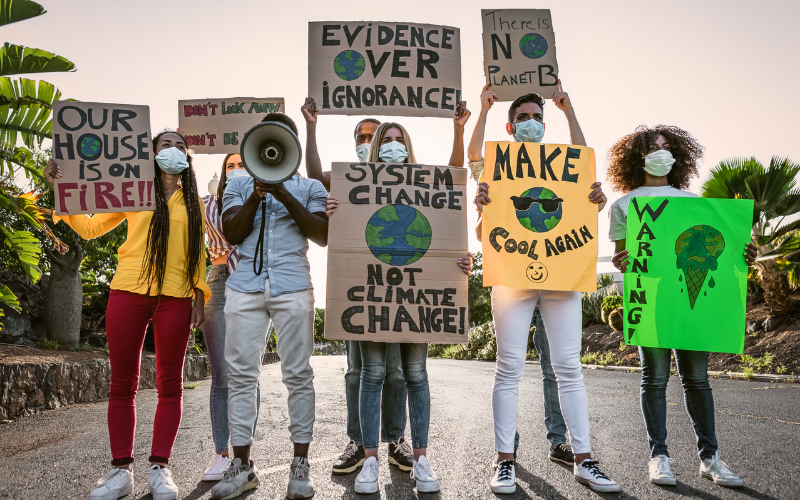Our current climate emergency is a complex problem which individuals, businesses and governments are addressing in a multitude of ways. From international agreements to carbon markets and legislation, via innovation in agriculture, industry, energy, and beyond, minds and money are being applied to a variety of solutions.
One approach that holds huge potential is harnessing the power of collective action. In this article we take a look at the power of collective action as it pertains to the climate crisis, offering evidence and encouragement for the role of collective action in solving complex problems, especially as an alternative—or complement to—top-down approaches.
Collective Action in Action: From California’s Farmers to Online Petitions

Collective action refers to a group of people working together to achieve a common objective. It takes place when people are mobilized to act en masse, spurred by a shared concern. Together the group wields a more potent power and influence. It has taken many forms over the last few decades, from the Suffragettes at the beginning of the 20th century to the pioneering civil rights movements of the U.S. in the 1950s and 1960s and the trade unions of today. More recently it has flourished, free of geographical boundaries, on social media and online platforms in the digital age.
A striking example of collective action was seen in California’s agricultural regions in the 1960s, when political activists Dolores Huerta and Cesar Chavez started the National Farm Workers Association (NFWA). The pair were fighting for better conditions, especially for grape pickers, who were toiling from dawn to dusk for 70 cents an hour with no cold drinking water or rest periods. Top-down government approaches hadn’t helped; state laws protecting workers were simply ignored by growers.
Huerta and Chavez worked at a grassroots level, traveling between the towns of the Central Valley recruiting farmworkers to the union. In 1965, their members joined other unions in a strike. It was risky for the workers. Many lived in company housing, had no legal protection, and were worried that growers would simply replace them. The growers did exactly that at first, relying on a network of other workers and their political influence in D.C. But the NFWA persisted, starting a system of roving pickets that allowed striking workers to persuade others to down tools and join the cause.
The workers began to organize boycotts of their employers and associated companies, exerting economic pressure and eventually forcing them to the bargaining table. Seventy strikers walked 340 miles from Delano near Bakersfield to Sacramento in 1966, the UFW says, picking up hundreds of friends and rallying with thousands of people. “A Chicano theater group, El Teatro Campesino, staged skits about the struggle from the back of a flatbed truck every night. The march attracted media attention and public support.”
It was a result of collective action focussed on workers rights and civil rights in general, amplified by a strong message. And it worked. (Another win, ten years later, was 1975’s Agricultural Labor Relations Act, which gave farm workers the right to collectively organize for better wages and conditions.)
Other examples of successful collective action include labor union UNITE-HERE winning panic buttons and other protections for hotel workers across the U.S. and Canada, Google workers protesting the company’s sexual harrassment policies, and teachers in Los Angeles striking for better schools.
In more recent years, collective action has taken place online—involving relatively less effort for often tangible results. Take the online petition, for example, which has had direct implications for government policy.
The Obama administration’s We The People platform may have been short-lived and imperfect, but a petition calling for cell phone unlocking, allowing consumers to switch phone networks, resulted in the Unlocking Consumer Choice and Wireless Competition Act of 2014. It was the first time a petition on the site led to a legislative change. After it received more than 114,000 signatures, the White House responded within two weeks. “The Administration and FCC worked with wireless carriers to reach a voluntary agreement to create more competition in the mobile space, lower prices, and increased flexibility for every American with a mobile phone,” a statement at the time said.
The UK also has a Petition Parliament platform, which sees petitions asking for a change of law or policy with more than 100,000 signatures considered for debate. Finn’s Law, or the Animal Welfare Sentencing Bill, which made attacking a service animal a criminal offense in 2021, resulted from a petition with 127,000 signatures that triggered a debate in parliament.
The Problem with Collective Action and the Tragedy of the Commons
Collective action often has a fundamental problem known, appropriately, as the collective action problem. While individuals in a group may share interests or concerns, they also retain their own, often conflicting interests. Furthermore, if individuals believe change will happen without their participation, they’re inclined to let others do the work. They’ll also avoid action if it’s costly. Those trade unions? Their victories improve the lives of all workers within a company or industry, not just those that paid their dues and took direct action. So where’s the incentive to put the time or money in, if others will benefit from your work?
That brings us to the tragedy of the commons, where individuals act in their own self-interest over the good of everyone, leading to depletion of resources. The concept dates back to 1833 and William Forster Lloyd’s example of cattle herders using more than their fair share of common grazing ground, and was famously revived in Garrett Hardin’s 1968 essay for Science.
The Tragedy of the Commons and the Climate Crisis

Overfishing is an oft-cited example of the concept, but the climate crisis has recently been posed as “the ultimate tragedy of the commons” (Jouni Paavola, professor of environmental social science at the UK’s Leeds University, in Property in Land and Other Resources, 2012).
Atmospheric sinks, which absorb more carbon than they release, are a common pool resource much like a fishery; units are subtractable (one unit used by one user isn’t available to others) and it’s hard to stop unauthorized users from using them. As Paavola wrote, “Users have incentives to use sink service units before other users make them unavailable, and it is difficult to prevent them from doing so.”
In 1965, economist Mancur Olson wrote in The Logic of Collective Action, that “unless the number of individuals in a group is quite small, or unless there is coercion or some other special device to make individuals act in their common interest, rational, self-interested individuals will not act to achieve their common or group interest.” His work led to the general belief that collective action can be ineffective thanks to the tendency for individuals to free ride.
Political economist Elinor Ostrom, the first woman to win the Nobel Memorial Prize in Economic Sciences, disagreed. She and her colleagues argued that collective action can be successful where top-down approaches haven’t—and conducted pioneering studies on how it can work, particularly as it pertains to the management of environmental resources.
“Extensive fieldwork has by now established that individuals in all walks of life and all parts of the world voluntarily organize themselves so as to gain the benefits of trade, to provide the mutual protection against risk, and to create and enforce rules that protect natural resources,” she wrote in Collective Action and the Evolution of Social Norms. Furthermore, noting the rise of self-organized collective action, she said: “If a small core group of users identify each other, they can begin a process of cooperation without having to devise a full-blown organization with all of the rules that they might eventually need to sustain cooperation over time.”
“Ostrom studied what makes collective action work in irrigation systems, pastures, forests, and fisheries all over the world,” Ruth Meinzen-Dick wrote for the Guardian in 2012 shortly after Ostrom’s death. “Co-operation to manage key resources is not automatic, but neither is the ‘tragedy of the commons’.” As others have noted, it was an optimistic approach.
Ostrom “helped us understand institutional diversity, and ways of governing the commons that build on people’s capacity for collective action,” Meinzen-Dick added. “Her research offers valuable lessons on how to craft rules and provide incentives for co-operation at the many levels needed for a sustainable future.”
Climate change has recently been addressed by international agreements such as the United Nations Framework Convention on Climate Change (UNFCCC) and the Kyoto Protocol (KP), but these wide-reaching strategies have only achieved “modest results” in curtailing greenhouse gas emissions, Paavola wrote. “Top-down solutions relying on the central role of the state have been a false panacea in the governance of many resources.”
Instead, like Ostrom, he advocated for institutional diversity and polycentric order, which is “likely to emerge in a bottom-up way when diverse actors in a phenomenon like climate change seek to realize diverse benefits (or to avoid diverse costs) that accrue on different scales.” In the words of Ostrom herself: “We cannot rely on singular global policies to solve the problem of managing our common resources: the oceans, atmosphere, forests, waterways, and rich diversity of life that combine to create the right conditions for life, including seven billion humans, to thrive.”
We’ve seen many examples of the polycentric approach in action. The Cities for Climate Protection Campaign includes more than 546 local governments committing to sustainable policies that reduce greenhouse gas emissions and improve air quality. Paavola also cited the Cement Sustainability Initiative, whose members represent almost two-thirds of global manufacturing outside China. The emissions of these kinds of collective organizations rival those of several countries.
But what if we could also harness the power of the individual, for a truly bottom-up grassroots approach?
The ubiquity of the effects of climate change has led to a dramatic ideological shift in recent years. The public is more concerned than ever, and willing to do something about it, as witnessed in increased climate activism and the flight shame movement. Seventy-two percent of citizens surveyed by the Pew Research Center in 17 advanced economies in North America, Europe, and the Asia-Pacific region in late 2021 voiced concern about climate change. Eighty percent said they were willing to change how they live and work to help address the issue. However, only 56 percent thought that society is doing a good job of tackling the problem and just 46 percent had confidence that actions taken by international communities will significantly reduce the effects of global climate change.
Tomorrow’s Air: A New Model of Collective Action in the Climate Realm

Tomorrow’s Air is a global network of individual travelers and travel businesses, joined together to support carbon removal education in travel and carbon dioxide removal with permanent storage.
Aware that they’re using common pool resources through traveling Tomorrow’s Air members support the necessary education and inspiration to power mass support for carbon removal as well as the removal and permanent storage of carbon dioxide from the atmosphere. The collective focuses on supporting frontier carbon removal approaches - negative emissions technologies that are necessary but because of their high cost today, are under-utilized. Tomorrow’s Air first carbon removal partner is direct air capture provider Climeworks, with additional carbon removal suppliers coming on board soon.
The Tomorrow’s Air approach to education and outreach includes a podcast, a newsletter, and a first of its kind Artists for Air program to help bring climate-conscious travel inspiration and education forward. Members receive access to goods and services from a curated community of benefits providers. As ATTA President and Tomorrow’s Air team member Casey Hanisko says, “we want to remove the barriers and the complexity to inspire and spark action.”
Tomorrow’s Air travelers are helping expand the global community of travelers understanding carbon removal and facilitating a reduction in atmospheric carbon; they’re also playing a key part in the learning curve of new technology.
New tech is expensive and risky. As the Union of Concerned Scientists (UCS) reported, citing a report on clean energy technology innovation from the National Academies, there are four ways that costs come down over time: research and development, learning by doing, economies of scale, and learning by waiting. That second point, learning by doing, is crucial. It’s why governments subsidized solar and electric vehicle use with gradually declining incentives.
“New technologies are first deployed in small and relatively cost-insensitive niches where their performance attributes are valued,” the UCS’s Peter O’Connor writes. “The learning effects reduce costs and enable the technology to succeed in a broader range of applications. Increased deployment leads to further cost reductions, which lead to further deployment.”
In 2021’s Speed & Scale: An Action Plan for Solving Our Climate Crisis Now, by John Doerr, carbon removal is Objective 8 in the overall plan for addressing climate change. Within that objective, which calls for 10 gigatons of removal per year, five is assigned to nature-based removal and five to engineered removal. “Without carbon removal at scale, emissions cuts would need to double each year through 2040 for us to reach net zero in time… To have even a chance to close our gap to net zero by 2050, we need to start funding and scaling all of [the removal solutions] now.”
“With future technological breakthroughs and economies of scale, engineered carbon removal could reach a commercial price of $100 per ton by 2030 and $50 per ton by 2040—95 percent less than it costs today.”
Tomorrow’s Air supporters are not alone. As Speed & Scale notes, payment service Stripe, which provides financial services for Amazon and Salesforce, launched Stripe Climate in October 2020: a new service allowing businesses to donate a fraction of their revenue to carbon removal. By June 2021, more than 2,000 businesses were “purchasing carbon removal at an average price per ton of more than five hundred dollars”. Stripe had already pledged $1 million per year for carbon removal at any price per ton in 2019, with, as the company’s Nan Ransohoff says, “the theory being that early customers can help accelerate promising new companies down the cost curve and up the volume curve”.
Whether individuals or companies, collective action is key. “No single business can create enough demand to scale carbon removal on its own,” Ransohoff says. But a global network of travelers coming together could help grow this new category of climate solutions and have an outsized impact.
Carbon removal is an essential part of the tool kit for addressing the climate crisis, and the collective action embodied by Tomorrow’s Air can help propel the necessary technology, providing a bottom-up solution in addition to other approaches—at a time when all hands are needed on deck. As Ostrom said, time is the natural resource in shortest supply.
